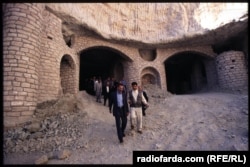Stunning landscapes, famous hospitality, and numerous World Heritage sites.
Iran’s potential as a holiday destination is vast, but foreign tourists have largely avoided the country ever since the Islamic Revolution in 1979.
The reasons are numerous. The visa process can be lengthy and complex. Some female visitors object to customary restrictions on dress. Alcohol consumption is heavily restricted. And, for many foreigners when considering a holiday in the Islamic republic, fears of detention and political upheaval enter the mind.
Under President Hassan Rohani, a relative moderate who won a second term in office with a convincing first-round victory in Iran's May 19 presidential election, the country has welcomed foreigners as part of an effort to improve its international image and boost an economy battered by low oil prices and years of crippling international sanctions imposed over Iran's contentious nuclear program.
Since the signing of a nuclear deal with world powers in 2015 that was the crowning achievement of Rohani's first term, tour companies have launched holiday packages and major European airlines have resumed regular flights to Iran. The number of foreign tourists has increased accordingly, and the cash-strapped government is planning to build on its tourism revival by easing visa restrictions and spending heavily to spruce up tourist accommodations and shabby transportation networks.
Read the full story on RFE/RL







